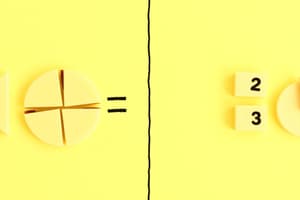Podcast
Questions and Answers
Which of the following fractions is equivalent to $\frac{3}{5}$?
Which of the following fractions is equivalent to $\frac{3}{5}$?
- $\frac{9}{15}$ (correct)
- $\frac{5}{3}$
- $\frac{15}{20}$
- $\frac{6}{15}$
Which of the following pairs of fractions are similar?
Which of the following pairs of fractions are similar?
- $\frac{1}{3}$ and $\frac{1}{4}$
- $\frac{2}{5}$ and $\frac{3}{7}$
- $\frac{4}{9}$ and $\frac{7}{9}$ (correct)
- $\frac{5}{8}$ and $\frac{5}{12}$
What is the least common multiple (LCM) of 12 and 18?
What is the least common multiple (LCM) of 12 and 18?
- 36 (correct)
- 24
- 6
- 72
Which of the following statements correctly compares the fractions $\frac{5}{7}$ and $\frac{7}{9}$?
Which of the following statements correctly compares the fractions $\frac{5}{7}$ and $\frac{7}{9}$?
What is the greatest common factor (GCF) of 24 and 36?
What is the greatest common factor (GCF) of 24 and 36?
Flashcards
Similar Fractions
Similar Fractions
Fractions with the same denominator.
Dissimilar Fractions
Dissimilar Fractions
Fractions with different denominators.
Equivalent Fractions
Equivalent Fractions
Fractions that represent the same value, even if they look different (e.g., 1/2 and 2/4).
Least Common Multiple (LCM)
Least Common Multiple (LCM)
Signup and view all the flashcards
Greatest Common Factor (GCF)
Greatest Common Factor (GCF)
Signup and view all the flashcards
Study Notes
- Fractions represent a part of a whole or, more generally, any number of equal parts.
- They are written as a/b, where 'a' is the numerator and 'b' is the denominator.
Kinds of Fractions
- Proper Fractions: Numerator is less than the denominator (e.g., 2/3).
- Represent a value less than 1.
- Improper Fractions: Numerator is greater than or equal to the denominator (e.g., 5/3).
- Represent a value greater than or equal to 1.
- Mixed Numbers: A whole number and a proper fraction combined (e.g., 1 2/3).
- Equivalent to an improper fraction (1 2/3 = 5/3).
- Unit Fractions: Numerator is 1 (e.g., 1/4).
- Represent one part of the whole.
- Complex Fractions: A fraction where the numerator, denominator, or both contain fractions (e.g., (1/2)/(3/4)).
- Can be simplified by dividing the numerator by the denominator.
Similar and Dissimilar Fractions
- Similar Fractions (or Like Fractions): Fractions with the same denominator (e.g., 2/5 and 3/5).
- Easily added or subtracted because the parts are the same size.
- Dissimilar Fractions (or Unlike Fractions): Fractions with different denominators (e.g., 1/3 and 1/4).
- Need to find a common denominator before adding or subtracting.
Comparing Fractions
- Comparing Fractions with the Same Denominator: Compare the numerators.
- The fraction with the greater numerator is the larger fraction (e.g., 3/5 > 2/5).
- Comparing Fractions with the Same Numerator: Compare the denominators.
- The fraction with the smaller denominator is the larger fraction (e.g., 1/3 > 1/4).
- Comparing Fractions with Different Numerators and Denominators: Find a common denominator and convert each fraction.
- Then, compare the numerators.
- Cross-Multiplication: A method to compare two fractions a/b and c/d.
- If ad > bc, then a/b > c/d.
- If ad < bc, then a/b < c/d.
- If ad = bc, then a/b = c/d.
Equivalent Fractions
- Equivalent Fractions: Fractions that represent the same value, even though they have different numerators and denominators (e.g., 1/2 = 2/4 = 3/6).
- Finding Equivalent Fractions: Multiply or divide both the numerator and denominator by the same non-zero number.
- Multiplying creates a fraction with larger numbers, but the same value.
- Dividing simplifies the fraction to its lowest terms.
- Simplifying Fractions: Dividing both the numerator and denominator by their greatest common factor (GCF).
Least Common Multiple (LCM)
- Definition: The smallest multiple that is common to two or more numbers.
- Finding the LCM:
- Listing Multiples: List multiples of each number until a common multiple is found.
- Prime Factorization: Find the prime factorization of each number, then take the highest power of each prime factor and multiply them together.
- Division Method: Divide the numbers by a common prime factor until no common prime factor remains.
- Use in Fractions: Used to find the least common denominator (LCD) when adding or subtracting dissimilar fractions.
- The LCD is the LCM of the denominators.
Greatest Common Factor (GCF)
- Definition: The largest number that divides two or more numbers without leaving a remainder.
- Finding the GCF:
- Listing Factors: List all factors of each number and identify the largest factor they have in common.
- Prime Factorization: Find the prime factorization of each number, then multiply the common prime factors with the lowest exponent.
- Division Method: Repeatedly apply the division algorithm until the remainder is zero. The last non-zero remainder is the GCF.
- Use in Fractions: Used to simplify fractions to their lowest terms.
- Divide both the numerator and denominator by their GCF.
Studying That Suits You
Use AI to generate personalized quizzes and flashcards to suit your learning preferences.
Description
This lesson explains the different types of fractions, including proper, improper, mixed, and unit fractions. It also covers similar and dissimilar fractions. Understanding these concepts is fundamental to working with fractional numbers.




